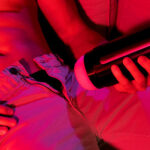Free Shipping over $69
Discreet and fast delivery
Free gift over $100+
Rewards program
Best price guarantee
Finding the G-Spot

Ah, the G-spot. The most mysterious and controversial of all human anatomy. Formally named the Gräfenberg Spot (sexy) after the gynaecologist who suggested that such an area existed, the idea of the G-spot didn’t really take off until the 1980’s. Sexologist Beverly Whipple coined the term when she started researching female sexual pleasure. Her work was so ground-breaking that the G-spot was almost named the “Whipple Tickle”. I’m sure we can all agree it’s a good thing it wasn’t.
Surprisingly, there’s still a lot we don’t know about the G-spot. And much of what we think we know is mired in controversy. So what can we say?
What is the G-Spot?
The G-spot is an area on the anterior vaginal wall – that’s the one closest to your belly button. It’s usually found 2 or so inches up, conveniently the general length of a finger. We used to think it was so sensitive is because it’s the meeting place of the vagina, clitoris, and urethra. Or the clitourethrovaginal complex if you will. This is where lower bulbs of the clitoris are stimulated through the walls of the vagina, along with the urethral sponge, AKA the female prostate.
However, a review published in 2022 found that the G-spot isn’t actually a singular spot at all! The latest research suggests that there are actually five erogenous regions of the G-spot: the clitoral corpora crura, vestibular bulbs, peri-urethral tissue, urethra, and the anterior vaginal wall. Nothing like whispering “caress my clitoral corpora crura” to really get things hot between the sheets.
Why is the G-Spot controversial?
Something that won’t surprise you is that there is a distinct lack of scientific knowledge about the vulva. Or vagina. Or female pleasure. The entire clitoral organ was only discovered in the late 90’s by Australian urologist and living legend Dr Helen O’Connell. Until then, science thought the visible pea-sized glans of the clitoris to be all there was. We still have so much to learn about the way vulvas and vaginas function, let alone experience pleasure, simply because no one has gone looking for it. In fact, science knows more about what goes on in the deepest parts of the oceans than it does about what’s in between our legs.
Along with the possibility of having a ‘G-zone’ rather than a ‘G-spot’, we’re still not sure if everyone has one. Or exactly what it is. A scientific review from 2012 failed to find an anatomical site, other than the clitoris, that led to orgasm when stimulated. So whenever you’re involved in a spot of G-spot play, you’re creating a sensation that is beyond scientific understanding!

But before we get to ways to stimulate your G-spot, there are a few myths to get out of the way first.
Will it give me a vaginal orgasm?
Thanks to centuries of misinformation around vulvas and pleasure, there are some pretty wacky ideas around orgasms. A recent article from the ever-informative and dependable magazine Cosmo listed different types of orgasms for women. Did you know you can have clitoral, nipple and even mental orgasms?
Look – an orgasm is an orgasm. There aren’t different types of orgasms, only different types of stimulation. Can some of it feel deeper or more intense than other forms of stimulation? Of course! That’s just how the human body works.
The idea of the vaginal orgasm is steeped in centuries of societal limitations of how sex should be conducted. Basically penis-in-vagina only. Yet, only 20-30% of vulva owners can reliably orgasm from vaginal penetration alone. If you can’t, that’s okay. There isn’t some secret part of you that needs to be unlocked in order to reach your full orgasmic potential.
You don’t need to go through your sex life trying to tick off every orgasm from your bucket list. Dr Emily Nagoski put it best in her book Come As You Are when she said, “an orgasm’s value comes not from how it came to be or whether it meets some arbitrary criteria but from whether you like it and wanted it”. I think that’s a pretty good way to view your orgasms.
There’s so much to say about vaginal orgasms, but if you want to read more I highly recommend Anne Koedt’s essay Myth of the Vaginal Orgasm. Spoiler alert: it’s all an old, white man’s fault.
Will it make me squirt?

Squirting, or rather, ejaculating, has become incredibly popular in the last few years. G-spot stimulation is a popular way to squirt, but there’s no one magical combination to squirting every time. Ejaculating during sex is very normal – yes, even if you have a vulva! It’s also a fun thing to explore on your own or with a partner. So to answer the question – maybe. If it does, great. If it doesn’t, that’s okay, try something else.
There’s a lot we don’t know about squirting, but it’s pretty widely accepted that it’s the expulsion of liquid from the urethra and paraurethral glands. If you want the full low down on squirting, check out this Wild Secrets article from Jules Vos here!
Am I missing out if I can’t find my G-Spot?
First things first – you might not have one, remember? Also, the G-spot is not the absolute height of sexual pleasure. You’re not missing out on some incredible orgasmic experience if you can’t find it or touching it doesn’t feel good. Exploring your body is about discovering what it can do, what feels pleasurable, and finding power in that.
The G-spot is not some magical button in every vagina that delivers instant and powerful orgasms. Some people may have an incredibly sensitive G-spot and other people won’t. As someone with vaginismus, G-spot stimulation is mostly off the table. Sure, I could dilate for an hour every day, buy bucketloads of lube, and find some way to become the most relaxed person in the world. But frankly, it’s not that important to me. That doesn’t mean it won’t ever be something I’m interested in exploring later. But for the time being I am utterly content finding ways to create pleasure firmly outside of my body.
Ways to explore your G-Spot
Although I have vaginismus, the women I sleep with don’t, so I do have pretty reliable sources when it comes to G-spot stimulation. So let’s get started. The most important thing you can do here is to let go of any expectations you have. Putting pressure on yourself in any sexual encounter is a great way to ensure disappointment – regardless of whether it’s on your own or with a partner. Relax, breathe. This is about exploring what makes you feel good.
Don’t dive right in. Vulvas usually take 20-40 minutes to warm up so take your time exploring your body. Or your partner’s body. Use this foreplay time to figure out what feels good. And don’t forget to use your favourite lube, which really should be accompanying penetration every time.
As mentioned previously, the G-spot is about 2 inches into the vagina on the wall closest to the belly. The best way I know to explore the G-spot is to curl your fingers in a sort of “come hither” motion. You want your finger tips to stroke the vaginal wall. You’re looking for a spongey or ridged texture similar to the roof of your mouth. It’s easiest for you or your partner to lie on their back, but if you’re having trouble finding the G-spot, it can be useful to have them pull their knees up towards their chest, which can help in achieving deeper penetration.
Remember, no two vaginas are the same, so there’s no reliable map to follow to the G-spot. Sometimes I find feeling slightly off centre helps. Remember it can take time for the spongey tissue to become aroused and swell, so keep the slow and rhythmic strokes up, and listen to your partner’s feedback.
Using sex toys for G-Spot exploration

If you enjoy G-spot stimulation, sex toys are an amazing addition to your self-pleasure kit. Or partner pleasure kit! I’m a fan of dildos – especially ones that are curved or textured. Glass dildos can also be used for temperature play, and they’re waterproof, so they’re a great option if you’re looking to add a little extra stimulation to your play. Or, if you’re looking for a bit more flexibility, silicone is always reliable.
Of course, vibrators – especially G-spot Vibrators – can feel amazing on the G-spot, and are a great option when you’re starting out. Again, ones that are just the tiniest bit angular and ridged can give you that extra bit of kick you or your partner need.
Remember, if you’re with a partner, communication is as vital as lube. Ask them what feels good, if the speed and pressure is right, and make sure they’re not only comfortable throughout the experience, but that they’re enjoying it. Mindfulness is also fantastic when you’re receiving, especially when you’re exploring new sensations. It’s important to focus on the pleasure, let go of expectations, and really stay in the moment.
What if I can’t find the G-spot?
Even if you’re unable to find the G-spot or if you do and you discover G Spot stimulation doesn’t feel great, pleasure should be at the centre of what you’re doing. Also, just because it’s not your vibe at the moment, it doesn’t mean that G-spot play isn’t for you! Your body is constantly changing, and a different set of circumstances or mindset could completely alter your G-spot experience. Remember, the G-spot isn’t a magical button to orgasm. Go slow, centre pleasure, and take power in knowing your own body.
















